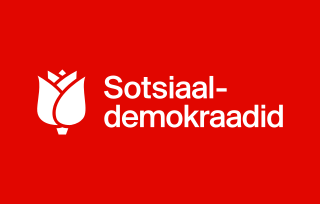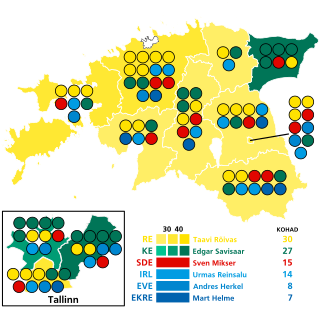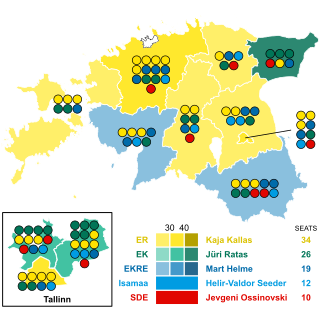
The history of Estonia forms a part of the history of Europe. Humans settled in the region of Estonia near the end of the last glacial era, beginning from around 9000 BC. Starting with the Northern Crusades in the Middle Ages, Estonia became a battleground for centuries where Denmark, Germany, Russia, Sweden and Poland fought their many wars over controlling the important geographical position of the country as a gateway between East and West.

The Estonian Centre Party is a populist political party in Estonia. It was founded in 1991 as a direct successor of the Popular Front of Estonia, and it is currently led by Mihhail Kõlvart.

The People's Union of Estonia was a political party in Estonia. Its last leader was Margo Miljand.

The Estonian Reform Party is a liberal political party in Estonia. The party has been led by Kaja Kallas since 2018. It is colloquially known as the "Squirrel Party", referencing its logo.

An election for Members of the European Parliament representing Estonia constituency for the 2004–2009 term of the European Parliament was held on 13 June 2004. It was part of the wider 2004 European election.
An election of Members of the European Parliament representing Netherlands constituency for the 2004–2009 term of the European Parliament was held on 10 June 2004. It was part of the wider 2004 European election. Fifteen parties competed in a D'Hondt type election for 27 seats.

The Social Democratic Party is a centre-left political party in Estonia. It is currently led by Lauri Läänemets. The party was formerly known as the Moderate People's Party. The SDE has been a member of the Party of European Socialists since 16 May 2003 and was a member of the Socialist International from November 1990 to 2017. It is orientated towards the principles of social-democracy, and it supports Estonia's membership in the European Union. From April 2023, the party has been a junior coalition partner in the third Kallas government.

Elections to the European Parliament take place every five years by universal adult suffrage; with more than 400 million people eligible to vote, they are the second largest democratic elections in the world after India's.

Parliamentary elections were held in Estonia on 2 March 2003. The newly elected 101 members of the 10th Riigikogu assembled at Toompea Castle in Tallinn within ten days of the election. Two opposing parties won the most seats, with both the Centre Party and Res Publica Party winning 28 seats in the Riigikogu. Res Publica was able to gain enough support in negotiations after the elections to form a coalition government.

Parliamentary elections were held in Estonia on 7 March 1999. The newly elected 101 members of the 9th Riigikogu assembled at Toompea Castle in Tallinn within ten days of the election. The elections proved disastrous for the ruling Estonian Coalition Party, which won only seven seats together with two of its smaller allies. Following the elections, a coalition government was formed by Mart Laar of the Pro Patria Union, including the Reform Party and the Moderates. It remained in office until Laar resigned in December 2001, after the Reform Party had left the same governing coalition in Tallinn municipality, making opposition leader Edgar Savisaar new Mayor of Tallinn. The Reform Party and the Estonian Centre Party then formed a coalition government that lasted until the 2003 elections.

Parliamentary elections were held in Estonia on 4 March 2007. The newly elected 101 members of the 11th Riigikogu assembled at Toompea Castle in Tallinn within ten days of the election. It was the world's first nationwide vote where part of the voting was carried out in the form of remote electronic voting via the internet.

Isamaa is a Christian-democratic and national-conservative political party in Estonia.

Indrek Tarand is an Estonian politician and a former Member of the European Parliament (MEP) from Estonia. He was an independent politician, but a member of the European Green Party.

An indirect presidential election took place in Estonia on August 29, 2011. There were two candidates: incumbent president Toomas Hendrik Ilves and European parliament deputy Indrek Tarand. For the first time in the country's post-Soviet history, only one round took place, as Ilves was able to secure the necessary two-thirds majority to get re-elected without a runoff. Ilves received 73 votes while Tarand obtained only 25. One vote was blank and two were disqualified. Ilves was supported by the ruling Estonian Reform Party and Union of Pro Patria and Res Publica, as well as the Social Democratic Party, to which he formerly belonged. Tarand was supported by the Estonian Centre Party.

An election for Members of the European Parliament from Estonia to the European Parliament was held on 25 May 2014.

An election of the Members of the European Parliament from the Netherlands was held on 22 May 2014. This is the 8th time the elections have been held for the European elections in the Netherlands.

Parliamentary elections were held in Estonia on 1 March 2015. Advance voting was held between 19 and 25 February with a turnout of 33 percent. The Reform Party remained the largest in the Riigikogu, winning 30 of the 101 seats. Its leader, Taavi Rõivas, remained Prime Minister. The newly elected 101 members of the 13th Riigikogu assembled at Toompea Castle in Tallinn within ten days of the election. Two political newcomers, the Free Party and the Conservative People's Party (EKRE) crossed the threshold to enter the Riigikogu.

Parliamentary elections were held in Estonia on 3 March 2019. The newly elected 101 members of the 14th Riigikogu assembled at Toompea Castle in Tallinn within ten days of the election. The Reform Party remained the largest party, gaining four seats for a total of 34 and the Conservative People's Party had the largest gain overall, increasing their seat count by 12 to a total of 19 seats.

An indirect election took place in Estonia in 2016 to elect the president of Estonia, who is the country's head of state. The Riigikogu — the Parliament of Estonia — elected Kersti Kaljulaid to be the next head of state of Estonia to succeed Toomas Hendrik Ilves, who had served his second and final term as president. Kaljulaid is the first female head of state of Estonia.

Triple Alliance is a commonly used political term in Estonia to refer to the various coalition governments between the centre-left Social Democratic Party, centre-right Reform Party and conservative Isamaa or their predecessors. This coalition has formed four times in history - from 1999 to 2002, from 2007 to 2009, from 2015 to 2016 and from 2022 to 2023. None of the coalitions governments have lasted a full parliamentary term. All of the Triple Alliance cabinets have been the second ones of the respective Prime Minister.


















